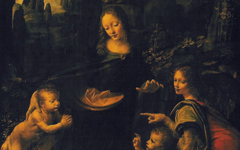Leonardo’s Hidden Faces, Part 2
Esoteric Christianity has been alive in some form or another since the beginning. Patrons in the Renaissance tended to follow exoteric Christianity (believing in the historical truth of Christ's life as taught by the Church) while artists followed its esoteric forms, known to only a few. Whatever the type - Gnosticism, Rosicrucianism, Theosophy etc. - all significant artists have known about or followed one of them. This leads them to depict the events of Christ's life in a similar way, as allegories of their own spiritual development inside their mind. Fortunately, other genres such as landscape and still-life can follow the same philosophy as easily as illustrations of the Bible. It is the theme that unifies the Western canon.
That is why, as I have shown before, a sketch for Leonardo's Last Supper is a double image showing Christ both at the table (its exoteric level) and Christ emerging from an old man's head. The hidden head has features very similar to those in Leonardo's portraits and caricatures of old men (the esoteric level).
Click next thumbnail to continue

L: Detail of Leonardo's Sketch for Last Supper;
C: Leonardo, Detail, inverted, of Old Man;
R: Diagram of Leonardo's Sketch
Click image to enlarge.
A quick review shows how. Christ's bent arm becomes the Old Man's "nose"; his "eye" is in the neck-opening. Leonardo, however, had to create the "eyebrow" with a straight line just below Christ's shoulders that is seemingly irrelevant to the image of Christ. The positioning of the eye, though, is particularly important because Christ's head is directly above it. In other words, out of the Old Man's "eye" comes Christ.
Click next thumbnail to continue
It is not surprising then that when Michelangelo paintedThe Last Judgment a half century later he based the entire composition on a visual illusion of "Dante's head in profile" with Christ in the center of "his brain". Although scholars have not mentioned Dante's presence in over forty tears, the technique was common practice among artists then and since.1 Leonardo, for instance, had used a similar visual illusion in a study of the Virgin and Child with a Cat (left).
Click next thumbnail to continue

L: Detail of Leonardo's Virgin and Child with a Cat;
C: Detail of Two Grotesque Profiles, inverted (c.1487-90);
R: Diagram of Virgin and Child with a Cat
Click image to enlarge.
Once again Leonardo has used the bent arm of his principal figure, the Virgin, as an old man's "nose". The "eye", as before, is in the neck-opening which includes, ever so faintly drawn, a circle which may represent a medallion on the exoteric level or nothing at all; on the hidden, esoteric level, though, the circle is the center or pupil of an old man's "eye". And just as Christ appeared above the old man's eye in the sketch for The Last Supper, so the Virgin - the receptacle of the Immaculate Conception - appears above his eye in this one and, thus, by implication in his mind.
Click next thumbnail to continue

L: Leonardo, Bearded Old Man in Half-Length (detail rotated)
R: Leonardo, Self-Portrait (detail)
Click image to enlarge.
Why Leonardo identified with these heads of old men with beak noses has always been in dispute, especially since he had begun drawing the elderly heads when he himself was much younger. It might have been what he imagined he would look like when old and wizened to symbolize the wisdom of old age. Remarkably, it has never been noticed before now that his later self-portrait (near left) is remarkably similar to the old men he portrayed. The one at far left may or may not depict St. Peter. Age, not youth, was the image of wisdom then so whatever his reason Leonardo's old men represent "Leonardo" himself and not just anonymous caricatures and drawings. It's time we all recognized that.
More Works by Leonardo
The widespread misconception that Leonardo's portraits are depictions of real people can only be grasped as a misconception when one recognizes that even his depictions of biblical figures are not what they seem.

Leonardo’s Faces
Notes:
1. Dante's profile was first noted in a book published in 1954 by a Venezuelan diplomat, Joaquin Diaz Gonzalez. It has been mentioned only once by an art historian, in the footnotes to De Tolnay's multi-volume work on Michelangelo and he seemed unpersuaded. That was over half a century ago. In the late 1960's two literary critics both found the presence of Dante's profile "persuasive" though no art expert has either corroborated their view or even mentioned it except this writer. I have published the finding numerous times in The Art Newspaper and on the web but still no art historian can bring themselves to accept that academic art history, as currently practiced, is so profoundly mistaken. See Joaquin Diaz Gonzalez, Scoperta d’un grande segreto dell’art nel Giudizio Universale di Michelangelo, 2nd. ed. (Rome: Angelo Belardetti) 1954; Charles de Tolnay, Michelangelo: The Final Period (Princeton University Press) 1960; Gian Roberto Sarolli, “Michelangelo: The Poet of the Night”, Forum Italicum 1, Sept. 1967, pp. 153-4; Robert J. Clements, The Poetry of Michelangelo (New York: New York University Press) 1966, p. 317
Original Publication Date on EPPH: 14 May 2011. | Updated: 0. © Simon Abrahams. Articles on this site are the copyright of Simon Abrahams. To use copyrighted material in print or other media for purposes beyond 'fair use', you must obtain permission from the copyright owner. Websites may link to this page without permission (please do) but may not reproduce the material on their own site without crediting Simon Abrahams and EPPH.




